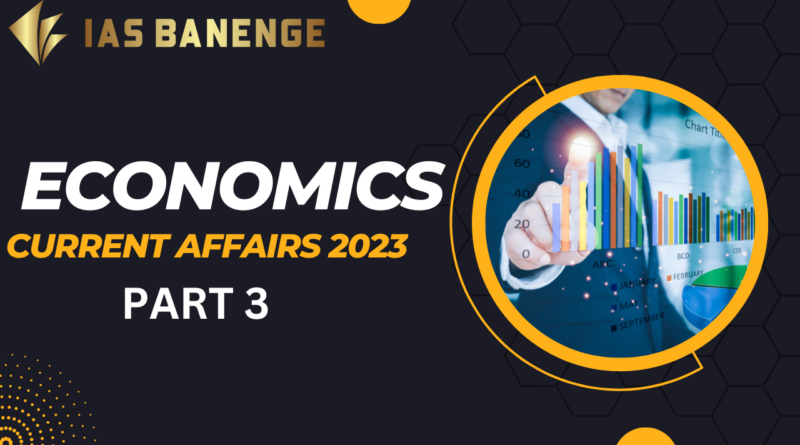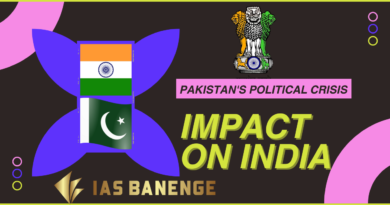Economics Current Affairs for UPSC 2023 I PART -3
PAYMENT SYSTEMS AND FINANCIAL MARKETS
1.INDIAN PAYMENT SYSTEM
RBI unveils ‘Payments Vision 2025’ for the next four years.
The payment system in India is regulated by RBI under the Payment and Settlement Systems Act, 2007. It plays a crucial role in economic development, financial stability, and financial inclusion. The Indian payment system is rapidly becoming digital with UPI, IMPS, and PPI transactions showing significant growth. The Payments Vision 2025 aims to enhance outreach, customer centricity, cyber security, and digital deepening through five anchor goalposts: Integrity, Inclusion, Innovation, Institutionalization, and Internationalization. The core theme is to provide Safe, Secure, Fast, Convenient, Accessible, and Affordable e-payment options to every user. In related news, UIDAI has introduced a new security layer in AePS to prevent fraudulent withdrawals, and NPCI provides AePS, a bank-led model that allows financial inclusion transactions at PoS using Aadhaar authentication.
2.OTHER DEVELOPMENTS IN PAYMENT SYSTEMS
| Topic | Details |
|---|---|
| RBI-DPI | Demonstrates significant growth in digital payments between March 2021-March 2022. Comprises of 5 parameters to measure deepening and penetration of digital payments. |
| SPSD | All payment system providers must store data in a system located only in India. Certified auditor audits the system and data can be shared with overseas regulators only after RBI approval. |
| BBPS | RBI has reduced minimum net worth requirement for non-bank BBPOUs from ₹100 crore to ₹25 crore. Driven by NPCI, it aims to offer interoperable and accessible bill payment services to customers via a network of agents, providing multiple payment modes and instant confirmation of payment. |
| MDR | Cost paid by a merchant to a bank for accepting digital payments, expressed as a percentage of the transaction amount. |
| FIU-IND | Independent national agency responsible for receiving, analyzing, and disseminating information related to suspect financial transactions. Reports to the Economic Intelligence Council and is a member of the Egmont Group of FIUs. |
3.CENTRAL BANK DIGITAL CURRENCY
RBI launches pilot project on Central Bank Digital Currency (CBDC) along with a Concept Note.
RBI has launched a pilot project on Central Bank Digital Currency (CBDC) and released a Concept Note on it. The objective is to create awareness about CBDCs and the proposed features of the digital Rupee. The design of the Digital Rupee will be based on the circumstances and needs to achieve financial and monetary stability. Two forms of CBDCs may be introduced: CBDC-Retail for private sector, non-financial consumers, and businesses, and CBDC-Wholesale for restricted access by financial institutions. The e₹ can be structured as token-based or account-based. CBDC in India would be based on the two-tier, indirect model and non-remunerative (non-interest bearing). The RBI Act, 1934 needs to be amended to include Digital Rupee in the definition of bank notes. CBDC is defined as the legal tender issued by a central bank in a digital form. It is pegged to the value of that country’s fiat currency and adds digital form to existing physical form of bank notes. The CARF, released by the OECD, provides for reporting of tax information on transactions in Crypto-Assets in a standardized manner, with a view to combating international tax evasion using digital assets such as cryptocurrency.
4.TOKENISATION
RBI’s Card-on-File Tokenisation Norms to be Effective from 1st October.
RBI’s card-on-file (CoF) tokenization norms will be effective from 1st October. CoF transactions involve a merchant storing a cardholder’s Mastercard or Visa payment details for future billing, and tokenization replaces those details with a unique code or token. Tokenization prevents merchants from storing sensitive card information and tokenization and detokenization can be performed by the card-issuing bank or authorized card networks like Visa or Mastercard. Over 10 crore tokens have already been generated, covering 60-70% of Indian cardholders.
5.UNIFIED PAYMENTS INTERFACE (UPI)
UAE Joins Bhutan, Nepal, and Singapore in Accepting UPI Payments.
The Unified Payment Interface (UPI) is an instant real-time payment system developed by the National Payments Corporation of India (NPCI) for facilitating inter-bank transactions. NPCI is an initiative of RBI and Indian Banks’ Association (IBA) for creating a robust payment and settlement infrastructure in India. NPCI operates several payment systems like RuPay, IMPS, NACH, ABPS, NFS, and Bharat Bill Payment System. In 2020, NPCI put a volume cap of 30% for Third Party App Providers (TPAPs) for UPI transactions, and the deadline for compliance has been extended till December 2024. UPI is the most successful real-time payment system globally, providing simplicity, safety, and security in P2P and P2M transactions using tools like BHIM.
6.DIGITAL BANKING UNITS (DBUS)
PM dedicates 75 DBUs to promote digital banking across India.
The 75 Digital Banking Units (DBUs) have been set up as a joint initiative of the Government, the RBI, the Indian Banks Association, and participating banks. All Scheduled Commercial banks (excluding Regional Rural Banks, Payments Banks and Local Area Banks) with past digital banking experience can set up DBUs. Eleven public sector banks, twelve private sector banks and one small finance bank have set up these DBUs. SCBs can open DBUs in Tier 1 to Tier 6 centers without seeking permission from RBI, unless otherwise specifically restricted.
7. DIGITAL LENDING
RBI’s guideline on digital lending became effective on December 1.
The digital lending guidelines apply to all regulated entities and lending service providers engaged by them to protect consumers from breach of data privacy, unfair business conduct, and exorbitant interest rates. The guidelines aim to address rising illegal lending apps, concerns over data privacy due to the use of AI and machine learning, and unregulated entities engaged in lending. Key provisions include executing all loan transactions directly in the bank account of the regulated entity without any third party involvement, providing a key fact statement to the borrower before execution of contract, appointing a nodal grievance redressal officer, and ensuring compliance with technology standards on cybersecurity. The guidelines also require enhanced due diligence by regulated entities before entering into a partnership with a lending service provider for digital lending.
8.CREDIT RATING
SEBI Issues Guidelines on Standardization of Rating Scales Used by Credit Rating Agencies (CRAs).
SEBI has issued guidelines on standardization of rating scales used by credit rating agencies (CRAs). These guidelines provide standardized symbols and definitions for issuer or corporate credit ratings, and allow CRAs to use modifiers to reflect comparative standing within the categories of AA to C. They also provide standard descriptors for Rating Watch and Rating Outlook. A credit rating is an opinion of a particular credit agency regarding the ability and willingness of an entity to fulfill its financial obligations in completeness and within established due dates. Presently, three prominent CRAs control 85% of the overall ratings market: Moody’s Investor Services, Standard and Poor’s (S&P), and Fitch Group. Credit ratings are categorized as investment grade and speculative grade, depending on the level of risk involved.
9.SOCIAL STOCK EXCHANGE (SSE)
SEBI introduces framework for Social Stock Exchanges (SSEs) to raise funds for social enterprises.
SEBI has introduced a framework for Social Stock Exchanges (SSEs) to provide social enterprises with an additional avenue to raise funds. SSE allows investors to buy shares in a social enterprise that has been vetted by an official exchange. Non-profit organisations and for-profit social enterprises having social intent and impact as their primary goal are eligible to participate in the SSE. SEs should disclose an Annual Impact Report within 90 days from financial year end. NPOs raising funds through Zero Coupon Zero Principal Instruments must disclose their Vision, Target Segment, etc.
10.SOVEREIGN GREEN BONDS (SGRB)
Approval of India’s Sovereign Green Bonds framework for issuance of bonds worth ₹16,000 crore by Ministry of Finance.
Ministry of Finance has approved India’s Sovereign Green Bonds (SGrB) framework, with an aim to issue bonds worth ₹16,000 crore. These bonds are used to fund projects with positive environmental and climate benefits. SGrBs carry guarantees related to the repayment of principal and payment of interest by the sovereign or government. The green projects funded by SGrBs are classified based on energy efficiency, reducing greenhouse gases emissions, promoting climate resilience and adaptation, and improving natural ecosystems and biodiversity. The proceeds will be deposited to the Consolidated Fund of India and made available for eligible green projects. Other types of bonds include fixed rate, floating rate, zero interest rate, inflation-indexed, blue, and rupee-denominated bonds or Masala Bonds.
11.INSTITUTIONS AND SYSTEMS IN THE FINANCIAL SECTOR
| Organization/Institution | Description |
|---|---|
| Investor Education and Protection Fund Authority (IEPFA) | Established by GOI in 2016 under the Ministry of Corporate Affairs to administer the Investor Education Protection Fund, make refunds, and promote investor awareness and protection. |
| SEBI Complaints Redressal System (SCORES) | A web-based centralized grievance redress system for the securities market, made mandatory for lodging complaints in 2018. |
| India International Bullion Exchange (IIBX) | India’s first IBX launched at the International Financial Services Centre (IFSC) at GIFT City to establish standard gold pricing and facilitate trade for small bullion dealers and jewelers. |
| Central Depositories Services India Ltd (CDSL) | A government-registered share depository, founded in 1999, that helps consumers store shares in a dematerialized form and is a crucial part of the capital market structure. |
| Financial Benchmarks India Private Limited (FBIL) | A private limited company jointly owned by FIMMDA, FEDAI, and IBA that develops and administers benchmarks for money market, government securities, and foreign exchange in India. |
| International Organization of Securities Commissions (IOSCO) | An international body founded in 1983 that brings together the world’s securities regulators as the global standard setter for the securities sector, working with G20 and FSB on the global regulatory reform agenda. India’s membership in IOSCO includes SEBI as an ordinary member, IFSCA as an associate member, and BSE, NSE, and Multi Commodity Exchange of India as affiliate members. |
12.OTHER CONCEPTS IN THE FINANCIAL SECTOR
| Term | Definition |
|---|---|
| NDF Market | A foreign exchange contract where two parties agree to exchange currencies for the prevailing spot rate. |
| Passive Funds | Investment instruments that replicate a market index or specific market segment. |
| Hybrid Securities | Investment instruments that combine two or more different financial instruments, commonly equities and bonds. |
| Poison Pill Strategy | A shareholder rights plan that allows existing shareholders to purchase additional shares in a company at a discount. |
| Anchor Investors | Qualified institutional buyers who buy shares in large quantities to help the company bring in other investors. |
| Infrastructure Investment | Trusts that allow direct investment of small amounts of money from individual/institutional investors in infrastructure. |
| Forward Premium | Interest rate differential between the Indian and US bonds. |
| Insider Trading | Purchasing or selling a publicly-traded company’s securities while in possession of unpublished price-sensitive information. |
| Front Running | A market malpractice where an individual buys shares in advance in bulk, knowing of a large upcoming share purchase order. |
| Commercial Paper | A short-term debt instrument issued by companies to garner funds for generally up to one year. |
| Participatory Notes | Financial instruments issued by a registered foreign institutional investor to an overseas investor to invest in Indian stock markets. |
| Alternative Investment Funds | Funds established to collect funds from sophisticated investors, whether Indian or foreign, for investing according to a defined investment policy for the benefit of its investors. |
| Venture Capital Funds | Investment funds that manage money from different investors seeking to provide capital in startup and small and medium-size enterprises. |
| Impact Investing | An investment strategy that aims to generate specific beneficial social or environmental effects in addition to financial gains. |
13.NEW INSURANCE RULES
Government Notifies Six New Rules to Boost Insurance Penetration in India.
IRDAI is an autonomous regulatory body established in 1999 to protect the policyholder’s interests and regulate the insurance and reinsurance industry in India. The new IRDAI rules include allowing corporate agents to tie up with 9 insurers, increasing the RS experimentation period to up to 36 months, and making the process of setting up an insurance company simpler. The use and file procedure has also been extended to life insurers to launch new products without prior approval. A committee appointed by IRDAI has suggested over a dozen low-cost micro-insurance modules to protect low-income people with affordable insurance products. These new rules are expected to increase insurance penetration in India, which was 4.2% in FY21.
14.PENSION SYSTEM IN INDIA
Old Pension Scheme vs New Pension Scheme: The Debate on Pension Reforms Intensifies.
India’s Pension System is highly complex and fragmented with various options including public pensions such as OPS and NPS, EPS for employees in the organized sector, government pension schemes, and pension plans from organizations like LIC’s Saral Pension. The introduction of NPS in 2004 replaced OPS for new entrants due to the increasing pension liability of the government and the unsustainable nature of OPS as pension liabilities kept climbing with increasing life expectancy due to better health facilities. However, armed forces personnel are still covered by OPS.





Pingback: "Is UPSC Changing Its Recruitment Pattern? Insights into the Latest Updates" - Ias Banenge
Pingback: Economics Current Affairs for UPSC 2023 I PART -4 - Ias Banenge
Agreed- Humanity mustn’t overlook this issue any more. So what now?